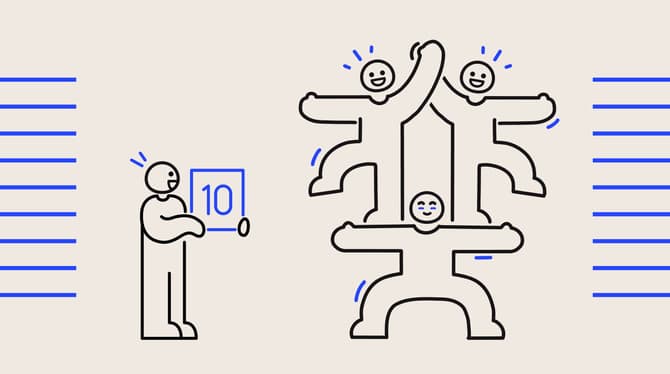The north star for many of today's managers is to empower their people to reach their full potential and feel engaged and valued in the workplace. After all, management is the human interface between an employee’s personal and professional goals and their development within the company.
But what does this look like in practice? A modern era of performance management is one in which annual reviews are combined with regular, meaningful conversations. Employees have a clear path forward with goals and expectations set with their managers as part of a collaborative process. And strong connections are forged through building trust and offering thoughtful recognition.
We’ve dug into the data of our employee engagement tool to get a glimpse of where employees and managers stand as they navigate this performance management shift, together.
We sourced numbers from our client database of more than 375,000 employees (managers included) over a one-year period. We uncovered average scores, rankings, and correlations between data points to better understand how employees really feel about their managers, the feedback they get, and how they’re developing at work.
Here’s something to kickstart our journey:
Our data shows that 40% of employees don’t have a development plan to improve their skills and drive their growth.
But don’t panic! This doesn’t mean that managers aren’t doing their best, or that employees are set up to fail. It simply shows that adapting to this new landscape of performance management systems comes with challenges, but we’re here to help.
Assess your organization’s employee experience in minutes

Discover ways to manage employee performance so your team can reach their full potential
What is performance management and why is it important?
Performance management is a process by which an employer involves its employees in improving organizational effectiveness. Essentially, it's continuous communication and feedback between managers and employees to ensure that employees are staying motivated to perform at their peaks.
Employee performance management is a powerful tool for engaging employees and aligning their performance to organizational objectives. It also enables managers to address any issues that may pop up along the way and may affect employee performance.
Performance management and employee engagement are closely connected, so taking certain initiatives with the former can really boost the latter. How? By scheduling regular meetings and performance reviews, setting clear goals and expectations, giving frequent feedback, recognizing achievements and efforts, nurturing employee development, and setting and tracking performance metrics (OKRs).
6 Ways to manage employee performance for better results
1. Continuous conversations for more effective feedback
An honest conversation can pay off in all sorts of ways, especially in terms of performance management.
When it comes to developing employees, good one-on-one conversations and the ability to give constructive feedback are essential. This calls for regular touchpoints so that managers can fine-tune and adapt the frequency, duration, and setting of conversations to the evolving needs of their employees.
The challenge can be finding this sweet spot. Employees might need more feedback during certain moments, like when they take on a new role or project, or when they’re facing challenges. With this in mind, Officevibe data reveals that only 25% of employees feel like the feedback they receive is frequent enough to help them understand how to improve, and 70% of employees say they’d like to spend more time with their manager.
5 quick tips for more meaningful conversations and impactful employee feedback:
- Have regular one-on-one meetings and be sure to check in between scheduled conversations to stay on top of issues that might need more immediate attention.
- Come prepared with agenda items for your conversations. You can even collaborate with employees and follow up on action items with a dedicated one-on-one meeting tool.
- Cut out all distractions during meetings. Put your phone or tablet away to make sure you're fully present in the conversation.
- Recognize employee strengths in a way that flows naturally rather than reading points off a list. Think of some ahead of time then express the impact their efforts have on the team.
- Take the time to form genuine connections to help build trust.
2. Collaborative development structures to empower employees
While employees have their own short- and long-term performance goals, and managers can help to align those within the objectives of the team and business, 27% of employees in our database do not feel they’re appropriately involved in decisions that affect their work.
Performance management structures should aim to change that because a stake in one’s own development is the cornerstone of employee engagement in the modern workforce. Employees want to feel that they can confidently voice their goals and know they have the agency to incorporate them into their career trajectory.
The new wave of performance management is more about harnessing employee potential. Rather than solely being motivated by a paycheque, employees seek intrinsic motivation from a sense of purpose. According to Officevibe data, 20% of respondents don't feel like they have the opportunity to do what they do best in their roles, so there's definitely room to improve by tapping into their strengths and leveraging their potential.
Setting individual goals in collaboration with your team members can help achieve this by giving employees a sense of purpose in their work. As a manager, it is a great way to see them grow in their role and stay motivated while staying aligned with the broader objectives.
2 quick tips to make employee development a collaborative effort:
- When you have a project or work goal, brainstorm more than one idea together with employees on how to achieve it.
- Open the floor to discussions on career path options within the company. These conversations inspire and create new opportunities.
3. Building strong connections
Humans are social animals; we crave connection with others and, as a testament to that, 86% of employees in our database report feeling that they are part of a team.
Managers have the unique opportunity to establish relationships with their team members that are founded on trust and mutual respect — this is the crux of it all, the foundation for leading employees to their full potential and fostering successful employee performance.
But deep connections don't just form out of nowhere. In fact, strong relationships depend on employees feeling comfortable expressing pain points, and confident that their managers will empathize and work with them to overcome these challenges. Managers need to take it a step beyond strengths-based coaching and dig into what their employees are really struggling with, and learn how to respond to feedback so they can improve work performance in certain areas.
When strong connections are formed and people feel comfortable communicating about anything at all — positive, negative, work-related or not — addressing difficult issues, working in close collaboration, and supercharging performance start to flow more smoothly.
4 quick tips to building connections with your employees:
- Share your own pain points with your employees.
- Use these phrase starters often: “How do you feel about…?” and, “What do you think about…?” and, “I’d love your take on…”
- Promote healthy work-life balance and show an interest in their outside-work activities.
- Understand where trust stands in your team and use your employees' feedback to improve it.
4. Setting clear expectations
While managing employee performance can sometimes feel like a balancing act, what never wavers is the need for clear-cut performance expectations. Success hinges on set goals, a clear collective vision, and an understanding of each individual employee's responsibilities. And it starts at the very foundation. Officevibe data revealed that 76% of employees say that the organization's long-term vision is clear to them, which sets them up for success.
What it comes down to is this: managers need to set clear expectations to build a culture of quality work and accountability. If employees feel any uncertainty about their roles or what is expected of them, it can lead to poor performance and high stress, and can even result in employee turnover. That's why it's crucial for managers to set clear expectations for each employee from the moment they're onboarded.
Officevibe's defining roles and responsibilities template can help you identify any gaps or lack of clarity in the way employees understand their roles, responsibilities, goals, and overall expectations. A little guidance can help support collaborative dialogue through helpful talking points, and help everyone come out of the conversation feeling more aligned!
Officevibe data shows that 94% of employees say that their responsibilities are clear, 89% say they're aware of what they're expected to deliver, and 78% say that their individual goals are aligned with team goals. These results show that clear and transparent communication on roles, responsibilities, and goals can help managers to keep their team aligned and performing at the highest levels.
4 quick tips to set and communicate clear expectations:
- Clarify your expectations by outlining specifically what you want, and when you want it by.
- Explain the "why" behind the work. This provides purpose and makes it more relatable.
- Have regular team meetings and one-on-ones to check progress and re-clarify where needed.
- Brush up on your communication skills and the way you lead your team.
5. Giving recognition where recognition is due
Perhaps one of the greatest motivators for employee performance is frequent, meaningful, and timely recognition. What does this mean? It boils down to one of the most basic human needs: to be noticed and appreciated beyond a review of their tasks. It’s not just about performance reviews that point out successful efforts and planning project expectations together; it’s about genuinely recognizing the employee as a bright, creative, and ambitious individual with personal plans to develop.
However, with only 71% of respondents being happy with how frequently they are recognized, it shines a light on the missed or awaiting opportunities to recognize employees in a meaningful way. Research shows that recognition, whether provided individually or in a group setting, can boost employee motivation, improve performance, and reduce attrition.
On the flip side, 88% say recognition is meaningful when they receive it from their manager or peers. That's right, it's important to remember that recognition doesn't just have to come from the top to be effective and meaningful. Don't underestimate the power and significance of recognition that is shared amongst peers.
💌 Make someone's day! Tools like Good Vibes give employees a simple, human way to recognize each other and spread a little joy within the team.
3 quick tips to improve employee recognition in your workplace:
- Make a habit of giving genuine, impactful recognition messages to your employees for both personal and professional accomplishments.
- Don't forget about virtual recognition to make sure everyone feels seen and valued, even when working remotely.
- Use employee recognition surveys to gauge how your employees feel about current recognition programs in place and identify areas for improvement.
6. Addressing poor performance
Just as it's necessary to recognize and reward great performance, it's equally important to address and rectify poor performance. While this is a more challenging and perhaps daunting task for some, it's needed to keep employees accountable, motivated, and on track for themselves and the organization as a whole. But what's key here is ensuring that you address poor performance and give feedback from an empathetic place.
As a manager, it's your responsibility to ensure your employees have the tools they need to succeed, so when performance is down, it's also up to you to tap into the reasons why and find the solutions needed to change the course. Poor performance is a symptom of a larger problem. Sometimes the issue is work stress or unmet goals and expectations, and sometimes the issues affecting employee performance are personal ones outside of the workplace. While 72% of employees say they have manageable stress levels at work, any number of factors can come into play to change that at any time.
On a human level, managers need to support employee well-being. This alone is worth its weight in gold for employees. With 76% saying their organization cares about their well-being, there's no doubt that this contributes to better performance and engagement in the long run.
4 quick tips to address poor performance at work and get back on track:
- Discuss poor work performance as soon as possible, during your next weekly or bi-weekly one-on-one meeting.
- Make sure you stick to the facts when going through your talking points. During difficult conversations, it's important to stick to observable behaviors and leave emotions aside.
- Ask questions to get your employee's perspectives on their performance and actively listen to what they have to say.
- Offer support to help them get through this tough time. This could be brainstorming solutions together or having more frequent one-on-one meetings.
How to measure employee performance
Now that we've explored ways to improve the employee performance management process, let's take a look at the ways managers can actually measure employee performance.
SMART goals
Rather than being lofty, goals need some kind of structure to be attainable. SMART goals are an effective way to set, achieve, and measure performance. SMART is an acronym that stands for:
- Specific: Specific goals are easier to achieve as they enable employees to know exactly what they’re working towards.
- Measurable: Measuring progress helps keep employees motivated and moving towards their goals. Clear KPIs and benchmarks enable employees and managers to track progress.
- Attainable: While everyone should aim high, each goal needs to be realistic and achievable. This helps keep employees motivated and committed to achieving their goals.
- Relevant: Goals should be relevant for both the employee and the organization, so ensure they're aligned with personal motivators, too.
- Time-based: Time parameters make it easier for goals to remain attainable as employees progress. They also help you break goals down into smaller action items.
OKRs
OKRs stands for Objectives and Key Results. Objectives are the big-picture goals you want your team members to achieve by the end of the quarter or year. Key results are specific metrics that help you track employee performance and see whether they’re meeting their objectives. It’s important that these two things align with each other. OKRs make it easy for employees to understand what’s expected of them and how their work contributes to the company’s goals.
Dive a little deeper into how you can define meaningful, attainable employee goals with our tips on SMART and OKR goal setting.
KPIs
Key performance indicators (KPIs) allow you to identify objectives, set clear goals, and hit your targets. They're quantitative and qualitative metrics that can be used to measure employee performance, track their ability to meet expectations and measure their impact on the business objectives. The results will show you where your employees are excelling and help you identify problem areas that need attention.
Tools like Officevibe
When it comes to implementing and measuring performance goals, Officevibe's goals and OKR tool support a comprehensive employee performance management system that can do it all. This tool is designed to engage and empower teams so that everyone can be involved in attaining organizational objectives. An easy-to-navigate map lets each team and individual contributor see where they fit in terms of reaching shared goals, unlock full visibility on your objectives by tracking alignment and goal progression, and so much more.
Ready to ride the new employee performance management wave?
With data and insights at hand, managers and team leaders hoping to harness the power of agile performance management and employee development can set off on the right track in crafting an effective performance management strategy. At the end of the day, your team is your most valuable asset so investing in them, connecting with them, and helping them feel valued is so valuable in itself.
That's why it's important to recognize that the source of an organization's wealth is its people, all of whom — managers included — want to have a clear understanding of their role, be aligned with the company's objectives, and contribute to the growth of something even greater.
Equip HR and managers with tools to engage, recognize, and drive performance.




